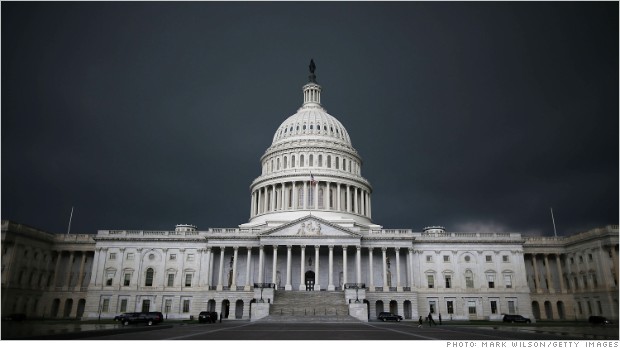
The United States lost its AAA rating in 2011 and is at risk of getting dinged again.
NEW YORK (CNNMoney)
Yes, we've seen this movie before.
In 2011, the last time Washington waited until the last minute to raise the debt ceiling, Standard & Poor's removed the United States' sterling AAA credit rating. This time around it's Fitch that has put the country on notice.
Stock investors did not react well to the last downgrade. When markets opened, all three major U.S. stock indexes lost between 5% and 7% -- the worst single day since the 2008 financial crisis.
Another downgrade in the days to come would surely grab headlines, but what are the implications?
Here's a primer on the rating agencies and their relationship to the chaotic events on Capitol Hill.
What do rating agencies do? The big three rating agencies -- Fitch, Standard & Poor's and Moody's -- rate debt based on the likelihood that it will be repaid. They rate everything from obscure derivatives to government bonds, with the safest bets labeled AAA. Some firms use their ratings as guidelines when making investment decisions.
What are the U.S. ratings? U.S. debt had been rated AAA by all three agencies for as long anyone can remember. Moody's, for example, first assigned the United States a AAA rating in 1917.
Right now, Fitch and Moody's have a AAA rating on U.S. debt. The country's S&P rating is AA+ -- still strong, but not the highest. It's on par with that of France, but below countries like the United Kingdom and Australia.
Why is another downgrade possible? Fitch said Tuesday that it had put the United States on review for a possible downgrade, saying the "political brinkmanship" on display in Washington increases the risk of the U.S. defaulting on its debts.
The country is now on "rating watch negative," meaning that there is increased possibility of a downgrade in the near future.
Related: Who owns U.S. debt?
Fitch took this action even while saying it expects a deal will be struck to raise the debt ceiling and avoid default.
But if they're wrong, look out. All three agencies would surely issue new downgrades if a debt payment is missed.
What do they mean by "default?" In this case, what technically constitutes default is a little murky.
The rating agencies look specifically at debt issued by the Treasury Department -- they don't care about other government obligations, like Social Security and Medicare payments.
Related story: 6 ways a default could hurt the world
Moody's has said that even if lawmakers fail to raise the debt ceiling by Thursday's deadline, the United States would likely be able to preserve its credit rating -- not to mention the stability of world financial markets -- by prioritizing interest payments on its debt over other obligations.
But others, including the Treasury Department itself, say this solution is unworkable.
What happens if we get downgraded again? Probably not too much. Back in 2011, some analysts feared the S&P downgrade could cause U.S. borrowing costs to soar. That didn't happen.
True, world markets lurched in the days following the downgrade, but rather than making borrowing more difficult, Treasury yields actually fell. More than two years later, the move appears to have had little lasting effect.
Why should anyone care what the rating agencies say? Analysts say the rating agencies no longer have they influence they once did on investors. Their critics say they lost credibility for their role in the housing crash, having stoking the bubble by blessing securities that contained bad-risk mortgages.
The rating agencies also face a particularly tough task when trying to quantify political risk -- a factor that is paramount when gauging the probability of a U.S. default.
The fiscal and political situation in Washington is well known, and the agencies are not basing their rating on any information that is not already available.
This suggests that investors may be better served by conducting their own analysis, and not relying on the credit rating agencies for insight. ![]()
First Published: October 16, 2013: 8:35 AM ET
Anda sedang membaca artikel tentang
Downgrades: 6 things you need to know
Dengan url
http://kasiatbuatsehat.blogspot.com/2013/10/downgrades-6-things-you-need-to-know.html
Anda boleh menyebar luaskannya atau mengcopy paste-nya
Downgrades: 6 things you need to know
namun jangan lupa untuk meletakkan link
Downgrades: 6 things you need to know
sebagai sumbernya


0 komentar:
Posting Komentar